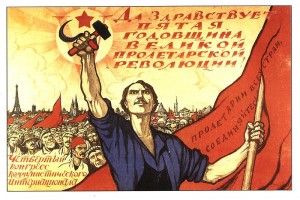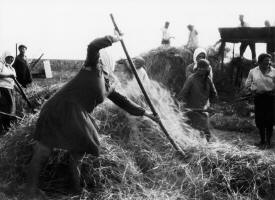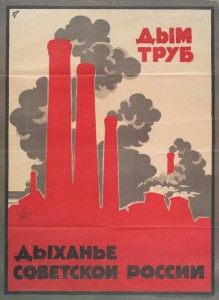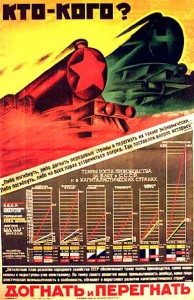The idea of a mode of production has its genesis amongst the political-economy theorists of the 19th century, a subject which was attracting so much interest was capitalism. Capitalism – quite a new system – represented a sharp change from the prior mode which was based on direct taxation of subsistence agriculture.
Indeed much of the interest paid to capitalism in the 19th century was driven directly by the tumult and disorganisation that it wrought on the population in moving them from a society based on agrarian production.
In the present era there has been a tendency to focus on the specific social institutions which make up a given economy. This is an eminently sensible approach when we are striving to differentiate modern capitalism from older forms, or the type of capitalism in one country from another. There are certainly big differences in outcome based on different institutions within capitalism. The Keiretsu of Japan, which are vertical interlocking business and banking relations, for instance, distinguish the character of Japanese capitalism as compared to the corporate capitalism of the US. The historical dirigisme of France, with its emphasis on state direction of key enterprises, colours French capitalism in significant ways which it would be foolish to ignore. These specificities are important when we are interested in judging reforms or how institutions alter the terrain, but we can also become lost in detail fairly easily and forget what is common.
Generalisations lose granularity and specificity, but they also give us useful ways of reasoning at a more abstract level from a “zoomed-out” perspective. The idea of a mode of production is essentially just such a generalisation which can allow us to “zoom-out”. If we combine this with a nuanced understanding of the particulars we are in a much better position to understand not only how various historical processes took place, but how we might get from where we are now to where we want to be.
The significant boundary between feudalism and capitalism hinges on the question of how the surplus in society is obtained. In feudalism 1, surplus is obtained by direct taxation on the producers. The producers, in this case farmers, produce an output which allows them a subsistence. The ruling class garners a surplus by direct taxation extracted from the farmers. In exchange, the ruling class uses the surplus both to provide protection to the peasants against other aspiring rulers and to directly suppress them if they get uppity, through the threat, or exercise, of violence. Some varying proportion of the surplus is then spent in conspicuous consumption by the ruling class.
By contrast, capitalism presented a very new system. While the particulars differed from place to place, it was characterised by a number of interlocking social institutions that created a very impressive dynamic. The process required some degree of mechanisation, where the productive increase could allow a group of entrepreneurs to invest money in mechanisation for the production of some consumable good. The workers who would assist in this production process would not be paid in kind, but in some currency. The commodities they produce are then sold at a market for a profit. The profit goes to the adventurous entrepreneur who would then use some of it for conspicuous consumption as with the nobility of the feudal class, but, in stark contrast to them, he also uses some of it to increase the efficiency of the productive process itself in order get even higher profits, thereby increasing their capacity for conspicuous consumption.
Because there are so many requirements for such a system to take hold, it was a very long time before this mode of production moved from the fringe to the total ubiquity that we now see. Indeed it requires so many social institutions to be in place that when viewed in its individual pieces it seems quite incredible that it was able to become so dominant. You need currency and banking institutions. You need a sufficiently large paying audience for your produced goods. You need some way to obtain funds to purchase capital prior to profits. You need a workforce who is disconnected from their ability to obtain subsistence and therefore willing to labour for wages. Without all of these factors, the system cannot function. Indeed capitalism had a very difficult (and often violent) time overcoming the chicken-and-the-egg conundrum this presents. However, once this feedback cycle was started it was both tremendously dynamic and expansive.
Those who promote visions of an alternative society will have to come to terms with the difficulty of starting such “virtuous cycles”. It is, indeed, no mean feat. Unfortunately, a lot of the understanding of how capitalism started was somehow lost in translation between its theorisation and the social movements of the 20th century that sought to move from capitalism to a new mode of production. The most exemplary of these movements is the Russian revolution of 1917.
While there have been a spate of ostensibly socialist revolutions over the course of the 20th century, it is not too hard to argue that the Russian revolution of 1917 was the most momentous both in its creation and its collapse. In fact, it managed to produce a new mode of production, albeit one which was short-lived and arguably less dynamic or successful than its capitalist rivals.
After the conquest of power, the Bolshevik Party were immediately confronted with an invasion by Germany. This helped to produce a paranoia and disintegration that resulted in a deadly civil war. Over this period there was a lot of putting out of fires, as well as the institution of ‘war communism’. Trotsky puts it thusly in Terrorism and Communism.
The introduction of compulsory labor service is unthinkable without the application, to a greater or less degree, of the methods of militarization of labor. This term at once brings us into the region of the greatest possible superstitions and outcries from the opposition.
Under existential threat, many economies have in fact instituted more or less primitive forms of planning, involving anything from direct acquisition of grain to feed troops, to the rationing system of the US during WWII, to the relatively sophisticated planning efforts of the British during the same period. Similarly to these other ephemeral efforts, ‘war communism’ dissolved once the immediate existential threat itself was removed, yet the militarisation of labour was to have a profound effect on labour relations from then on. It was at this point that the Bolshevik Party had some period of reflection, taking stock of where they were and was then possible from their position. Bukharin relates this experience shortly after the closing of the civil war:
The experience of the Russian Revolution has proved that our former notions of the revolutionary process were rather naive. Even the orthodox Marxian section thought that all the proletariat had to do to take over the technical apparatus after ejecting the upper layers of the bourgeoisie was to capture the reins of power.
The Bolsheviks had been quite surprised by the limited avenues open to them once in power for reconfiguring the mode of production. Ultimately, Lenin decided that some period of state capitalist development was going to be necessary to lay the basis for a more substantial transformation to socialism. This was made official policy when the NEP (New Economic Policy) was adopted.
However the left wing of the Bolsheviks eventually won out against this slow state capitalist development policy and it was decided to implement the compulsory collectivisations which later became synonymous with Stalinism. In fact, Stalin had previously sided with the right-wing and had what was viewed as an economically right-wing position, and it was his adoption of a version of Trotsky’s left-wing programme which allowed him enough support to unite the majority. The left’s economic programme of collectivisation rather than state capitalist development became official.
In order to industrialise rapidly, they required high levels of surplus and a large amount of this surplus was going to have to be grain. Since the peasants were not terribly interested in the goods being produced from industry there was a conundrum in trying to get them to produce sufficient quantities of grain. The collectivisation programme was supposed to overcome this problem by providing kolkhoz (the collective farms) with suitable mechanised infrastructure to increase output.
The collectivisation led to tremendous unintended consequences. Though emancipated from serfdom under Alexander II, peasants were still viewed as having use-rights from an Obshchina – through which they owed a very heavy obligation (around 50%), owed a ransom, and were not able to sell the land on which they produced. Richer peasants had to purchase new land to make use of it for production for profit. The 1917 revolution had given them the confidence that these tiny plots were in fact theirs, a view that Lenin had encouraged Socialists to adopt in their slogans since at least 1906. This led them to adopt a mentality of conservatism about what little they had, and they had further developed a not unreasonable fear of the Bolsheviks due to the grain requisitioning programmes which occurred in the first three years during the civil war. The peasants were made to pool their assets in the kolkhoz, including whatever livestock they had. In response a vast number of peasants decided to slaughter their animals rather than give them over to management in the kolkhoz leading Rykov to state:
For the first time in their sordid history, the Russian peasants have had their fill of meat.
Bukharin once commented that anyone with a cow had become a Kulak (a petty bourgeois farmer) in the eyes of the party. The liquidation of the Kulaks became a central theme, and an excuse for a range of very coercive actions. A joke once related to me recalls this period:
A party official hears that a certain peasant is not favourable towards the collectivisation. The party official says to the peasant: “Comrade, I’ve heard that you may not be a friend of the revolution. Prove your nay-sayers wrong and tell me, will you give your cow for the revolution? The peasant replies, “Yes, of course. I will give my cow for the revolution”. “Then,” replies the official, “Will you give your pig for the revolution?” The peasant thinks a bit and says: “Yes, I will give my pig for the revolution.” The official then says, “Finally, comrade, will you give your chicken for the revolution?” The peasant looks back and says: “This I will not do. I cannot afford to lose my chicken.” The official taken aback says, “But this is inconsistent, you will give your cow and pig but not your chicken?” The peasant replies: “I don’t have a cow or a pig.”
The end outcome of any programme of the reorganisation of labour which has no support amongst the workers is going to require coercion. And so it was with the collectivisations the state’s arm had to grow commensurately long. While this was going on through the 1930s the party itself began to further degenerate, with the first of the Old Bolsheviks (as the original grouping from 1917 was known in contradistinction to late comers) falling in show trials, starting with Zinoviev and Kamenev in 1936.
Industrialisation everywhere has been a traumatic experience. We should not be fooled into thinking that brutality was evaded in the industrial revolution in England or elsewhere. Living conditions in the capitalist countries deteriorated for workers even beyond what they had experienced as peasants or artisans 2. The Bolsheviks similarly were not exempt from the birthpains of development, moreover they compressed them into an immensely short period making the upheaval quite extreme. The entire industrial revolution which had taken a century in England was compressed, like an accordion, into a period of some 30 years.
The city of Magnitogorsk stands as a monument to this frenetic development. As part of the first Five-Year Plan which began in 1928 it would be the flagship of Soviet steel production. The development of the facility was contracted to an American consulting company, Arthur G. McKee, as indigenous industry was frightfully primitive.
The first Five-Year Plan looks like almost video-game simplistic in its aims, seeking vast quantities of the most basic raw materials
Pig iron: 6.2 million tons
Steel: 5.9 million tons
Coal: 64.3 million tons
Oil: 21.4 million tons
Electricity: 13.4 billion kWh
Magnitogorsk was to supply 4 million tons of Steel alone. The human costs of this were extreme. As soon as the rail-line was completed in 1929, a flood of workers arrived. They were housed in barracks which filled and then overflowed into mud-huts almost immediately. The population grew from a few hundred to a few hundred thousand virtually overnight.
This rapid state directed accumulation through the five year plans did eventually lead to an advanced industrialised society. Moreover, unlike any proceeding industrialisation, the entire system had been driven not by capitalist investors attempting to maximise profits, but by a conscious centrally directed policy of industrial development conducted by Gosplan (Government Planning).
Some socialists have claimed that the USSR was effectively state capitalism. This view, which probably started from an admission by Lenin that they were undergoing a period of state capitalism with the NEP, cannot be reconciled with the actual dynamics of the economy, something we will go into in some detail later.
The former capitalist social relations had indeed been abolished. The Kulaks and all capitalists had been entirely liquidated. Gosplan, and the bureaucrats which ran it, ascended to take all major planning decisions and eventually all industry was organised on the basis of meeting plan targets. The previous mode of production had been successfully replaced through force of will, coercion and at times, terror. No longer was investment decided by a group whose primary motivation was a personal profit from the success of any individual industry. While there were some changes in pay grade or promotions that could be won, the pay differentials were small, and did not include the ability to liquidate a position and invest elsewhere. Instead all increases in productivity were in fact accrued as a collectivity, even if one marked by some inequality of pay and some fairly large inequalities of control. Indeed the system developed its own infernal dynamics, dynamics entirely unique to a system of state planning.
In the next instalment we will discuss the economic system in more detail and its growth into a unique mode of production.
- Feudalism, absolutism etc are all treated here as identical even if there are significant differences in their political manifestations. The main concern is that the pressures on these regimes are all similar, in that they must take the surplus from the producer through tax and must acquire land to increase surplus. ▲
- See href=”http://www.victorianweb.org/history/workers2.html”>http://www.victorianweb.org/history/workers2.html ▲















